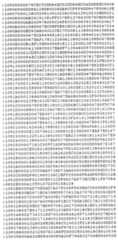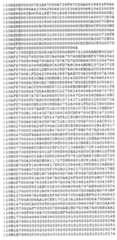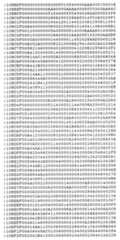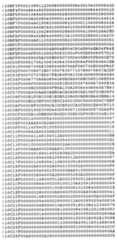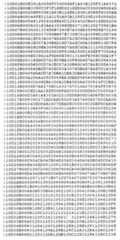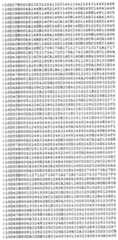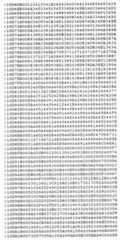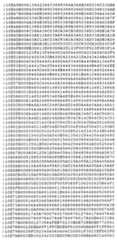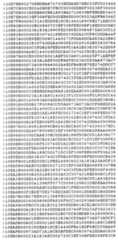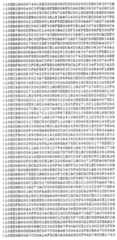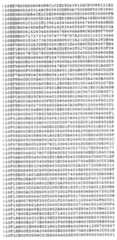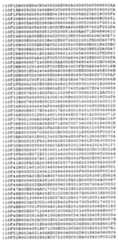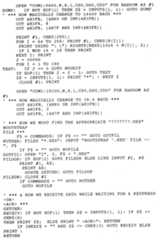EP0722148A2 - Bar code reader - Google Patents
Bar code readerDownload PDFInfo
- Publication number
- EP0722148A2 EP0722148A2EP96420003AEP96420003AEP0722148A2EP 0722148 A2EP0722148 A2EP 0722148A2EP 96420003 AEP96420003 AEP 96420003AEP 96420003 AEP96420003 AEP 96420003AEP 0722148 A2EP0722148 A2EP 0722148A2
- Authority
- EP
- European Patent Office
- Prior art keywords
- bar code
- code reader
- symbol
- reader according
- memory
- Prior art date
- Legal status (The legal status is an assumption and is not a legal conclusion. Google has not performed a legal analysis and makes no representation as to the accuracy of the status listed.)
- Withdrawn
Links
Images
Classifications
- G—PHYSICS
- G06—COMPUTING OR CALCULATING; COUNTING
- G06K—GRAPHICAL DATA READING; PRESENTATION OF DATA; RECORD CARRIERS; HANDLING RECORD CARRIERS
- G06K7/00—Methods or arrangements for sensing record carriers, e.g. for reading patterns
- G06K7/10—Methods or arrangements for sensing record carriers, e.g. for reading patterns by electromagnetic radiation, e.g. optical sensing; by corpuscular radiation
- G06K7/10544—Methods or arrangements for sensing record carriers, e.g. for reading patterns by electromagnetic radiation, e.g. optical sensing; by corpuscular radiation by scanning of the records by radiation in the optical part of the electromagnetic spectrum
- G06K7/10821—Methods or arrangements for sensing record carriers, e.g. for reading patterns by electromagnetic radiation, e.g. optical sensing; by corpuscular radiation by scanning of the records by radiation in the optical part of the electromagnetic spectrum further details of bar or optical code scanning devices
- G06K7/10851—Circuits for pulse shaping, amplifying, eliminating noise signals, checking the function of the sensing device
- G—PHYSICS
- G06—COMPUTING OR CALCULATING; COUNTING
- G06K—GRAPHICAL DATA READING; PRESENTATION OF DATA; RECORD CARRIERS; HANDLING RECORD CARRIERS
- G06K17/00—Methods or arrangements for effecting co-operative working between equipments covered by two or more of main groups G06K1/00 - G06K15/00, e.g. automatic card files incorporating conveying and reading operations
- G06K17/0022—Methods or arrangements for effecting co-operative working between equipments covered by two or more of main groups G06K1/00 - G06K15/00, e.g. automatic card files incorporating conveying and reading operations arrangements or provisions for transferring data to distant stations, e.g. from a sensing device
- G—PHYSICS
- G06—COMPUTING OR CALCULATING; COUNTING
- G06K—GRAPHICAL DATA READING; PRESENTATION OF DATA; RECORD CARRIERS; HANDLING RECORD CARRIERS
- G06K19/00—Record carriers for use with machines and with at least a part designed to carry digital markings
- G06K19/06—Record carriers for use with machines and with at least a part designed to carry digital markings characterised by the kind of the digital marking, e.g. shape, nature, code
- G06K19/06009—Record carriers for use with machines and with at least a part designed to carry digital markings characterised by the kind of the digital marking, e.g. shape, nature, code with optically detectable marking
- G06K19/06037—Record carriers for use with machines and with at least a part designed to carry digital markings characterised by the kind of the digital marking, e.g. shape, nature, code with optically detectable marking multi-dimensional coding
- G—PHYSICS
- G06—COMPUTING OR CALCULATING; COUNTING
- G06K—GRAPHICAL DATA READING; PRESENTATION OF DATA; RECORD CARRIERS; HANDLING RECORD CARRIERS
- G06K7/00—Methods or arrangements for sensing record carriers, e.g. for reading patterns
- G06K7/10—Methods or arrangements for sensing record carriers, e.g. for reading patterns by electromagnetic radiation, e.g. optical sensing; by corpuscular radiation
- G06K7/14—Methods or arrangements for sensing record carriers, e.g. for reading patterns by electromagnetic radiation, e.g. optical sensing; by corpuscular radiation using light without selection of wavelength, e.g. sensing reflected white light
- G—PHYSICS
- G06—COMPUTING OR CALCULATING; COUNTING
- G06K—GRAPHICAL DATA READING; PRESENTATION OF DATA; RECORD CARRIERS; HANDLING RECORD CARRIERS
- G06K7/00—Methods or arrangements for sensing record carriers, e.g. for reading patterns
- G06K7/10—Methods or arrangements for sensing record carriers, e.g. for reading patterns by electromagnetic radiation, e.g. optical sensing; by corpuscular radiation
- G06K7/14—Methods or arrangements for sensing record carriers, e.g. for reading patterns by electromagnetic radiation, e.g. optical sensing; by corpuscular radiation using light without selection of wavelength, e.g. sensing reflected white light
- G06K7/1404—Methods for optical code recognition
- G06K7/1408—Methods for optical code recognition the method being specifically adapted for the type of code
- G06K7/1417—2D bar codes
- G—PHYSICS
- G06—COMPUTING OR CALCULATING; COUNTING
- G06K—GRAPHICAL DATA READING; PRESENTATION OF DATA; RECORD CARRIERS; HANDLING RECORD CARRIERS
- G06K7/00—Methods or arrangements for sensing record carriers, e.g. for reading patterns
- G06K7/10—Methods or arrangements for sensing record carriers, e.g. for reading patterns by electromagnetic radiation, e.g. optical sensing; by corpuscular radiation
- G06K7/14—Methods or arrangements for sensing record carriers, e.g. for reading patterns by electromagnetic radiation, e.g. optical sensing; by corpuscular radiation using light without selection of wavelength, e.g. sensing reflected white light
- G06K7/1404—Methods for optical code recognition
- G06K7/146—Methods for optical code recognition the method including quality enhancement steps
- G06K7/1473—Methods for optical code recognition the method including quality enhancement steps error correction
Definitions
- This inventionrelates to two-dimensional bar code readers. More particularly this invention relates to a self-contained bar code reader that is fully capable of reading and decoding both one-dimensional bar codes and two-dimensional bar code symbologies such as PDF417.
- Code Oneis a two-dimensional matrix symbology that can encode the full ASCII 256 character set in addition to four function characters and a pad character. This symbology has ten different versions defined, with 27 - 50% of the symbol characters allocated to error detection and correction. Some versions use Reed-Solomon error control.
- PDF417Another two-dimensional bar code symbology is PDF417.
- PDF417is explained in Wang, U.S. Patent No. 5,243,655, which is incorporated herein by reference.
- the scannercan identify the cluster of a particular code word, and hence its row identifier modulo 3. This local row identification is particularly useful when the scanning axis is not perfectly aligned with the rows of the symbol, and a transition between two rows occurs during a scanning operation. Detection of row crossing permits "scan stitching" -- a mapping of partial row scans into a matrix or memory. Missing pieces in the partially completed matrix can be filled in by other scanned data, possibly from entirely different rows, either because the data is redundantly expressed in the symbol, or with the use of error correction algorithms such as Reed-Solomon codes.
- a typical scan stitching methodis disclosed in Pavlidis et al., U.S. Patent No. 5,241,164.
- a portable, hand-held, self-contained two-dimensional bar code readeradapted to the PDF417 symbology, including a light source, a photodetector, and a decoder.
- the decodercomprises an 8 bit microcomputer, having an address space of 64 Kbytes, but actually using an 8 KByte SRAM for data storage, and 32 KByte programmable erasable read only memory (PEROM) for program instructions.
- Performanceis enhanced by a novel program resident in the PEROM, and by the use of a direct memory access to load signals derived from the photodetector into memory.
- the unit's housingis approximately 71 ⁇ 2 x 31 ⁇ 2 x 2 inches. It weighs 71 ⁇ 2 oz., and during a reading operation, its power draw is 1.4 watts average during scanning, and 0.83 watts during decoding with the illumination off.
- the light sourceilluminates a narrow strip on the bar code symbol, and the photodetector's field of view corresponds to the strip.
- the photodetectoris a CCD matrix that acquires an image of the entire bar code symbol.
- the photodetectoris a photodiode
- the light sourceis a rasterizing laser that scans the symbol in a row wise fashion.
- the analog signalsare passed through signal processing electronics 20 which provide signal conditioning and analog-to-digital conversion, and digitization. Digitization is accomplished using an analog reconstruction circuit which is disclosed in U.S. Patent No. 5,294,783, of common assignee herewith, and also incorporated herein by reference.
- the resulting signalis submitted to a microcomputer 30.
- the microcomputer 30performs various tasks necessary to the operation of the system. It includes a microcontroller 40, realized as a Motorola MC68HC11D0CFN3, and has an address space of 64 Kbytes. The MC68HC11D0CFN3 is also provided with serial and parallel I/O, interrupt logic, an oscillator, and clock logic. As employed in the microcomputer 10, the microcontroller 40 is provided access to an 8 KByte static RAM 42 and a 32 KByte PEROM 45. The capabilities of the microprocessor 40 are enhanced by a multifunctional ASIC 35. As shown in FIG. 2 the ASIC 35 has four principal functional blocks.
- the internal clock logic of the microcontroller 40is controlled via the ASIC 35 by an oscillator having a crystal 49.
- an oscillator having a crystal 49To increase the performance of the system, and to handle the high computational load imposed by the decoding of PDF417 symbols, a crystal having a frequency of 14.7456 MHz, has been substituted for the 7.3728 MHz crystal which is furnished in the unmodified ST3000-22 model.
- Other modifications to the basic ST3000-22 modelare as follows: SRAM 42 is a 70ns 8K x 8 CMOS RAM (SONY part number CXK5864BM-70L).
- Microprocessor 40is a Motorola MC68HC11D0CFN3.
- PEROM 45is a 90ns model (ATMEL AT29C256-9).
- the doubling of the crystal frequencyis the most important contributor to performance, while the substituted SRAM, microprocessor, and PEROM insure component reliability at the increased clock frequency.
- Firmware resident in the PEROM 45contains the executable instructions for the microcontroller 40. Portions of the program realized in the PEROM 45 are conventional, and allow the bar code reader 10 to function as a conventional autodiscriminating reader for linear bar code symbologies, as well as to decode PDF417 symbols.
- the firmware 60consists of 4 main blocks, as shown in FIG. 3.
- a variety of system supervisory functions, indicated by reference numeral 62include the initialization of volatile hardware and memory regions, controlling and sequencing the scanning and decoding operations, and monitoring and maintaining I/O between the bar code reader, the operator, and external equipment.
- Decoding functionsare accomplished in several stages. First a preliminary evaluation for the presence of a bar code symbol of interest is made. When such a bar code symbol is detected a detailed character-by-character decoding operation is performed in areas of interest. Error checking of the decoded character string is then accomplished, and finally the decoded characters are interpreted to determine their corresponding data message. In the case of linear symbologies, the decoding result from a scan is a message ready for transmission. In two-dimensional symbologies, such as PDF417, a decoding result is partial information which is stored in the static random access memory (SRAM) array 42 (FIG. 1), and later combined with the results of subsequent decoding operations, until the full data message is eventually compiled for transmission.
- SRAMstatic random access memory
- Listing No. 1is then downloaded directly into the PEROM 45.
- Listing No. 2is executed in accordance with well known techniques specified by Motorola.
- the ST3000-22is first connected to COM1 of an IBM PC (trademark) or compatible personal computer running DOS, having Listing No. 2 loaded into the BASIC interpreter, and having Listing No. 1 available in a file.
- the ST3000-22is powered up in bootstrap mode.
- Listing No. 2is executed in the personal computer. Pressing any key of the personal computer will initiate the installation of a download program into the internal RAM (not shown) of the MC68HC11D0CFN3.
- the userthen responds to a prompt by entering the name of the file containing Listing No. 1.
- Listing No. 1is then downloaded directly into the PEROM 45.
- the firmware 60 in accordance with the inventionoperates on PDF417 symbols using a two-step process.
- the First step executed by the microcomputer 30 in accordance with the instructions in Listing No. 1is row decoding. This step is similar to linear bar code reading, and comprises the location of sequences of PDF417 symbol characters adjoining a start or stop character.
- What makes PDF417 scanning more computationally intensive than scanning linear bar codes, for example code 39 and UPC,is the allowance for "scan stitching", wherein decoding must be able to follow scans that move between different rows.
- the large 17-module characters within the large PDF417 character setpreclude normal look-up procedures because the PEROM 45 is limited in size.
- the second stepis message or array decoding, wherein the decoded PDF417 characters are placed into appropriate positions of a row and column matrix that is representative of the symbol. Then the rows, considered as one concatenated string, are error checked, error corrected, and finally interpreted into the encoded message. All of this is accomplished within the limitations of the 8K SRAM 42.
- the decoded informationis output through a conventional communication interface 55.
- User interfaces 50provide audiovisual indicators to the operator of the progress of the scan, and the results thereof. Such an interface is disclosed in copending Application Ser. No. 08/137,640, of common assignee herewith.
- the bar code reader 10is autodiscriminating and capable of reading several well known linear bar code symbologies, including, for example, UPC.
- the deviceis used by placing the reader 10 in contact or near contact with the symbol 18, which can be a PDF417 symbol.
- the readeris preferably approximately aligned with the rows of the symbol. Reading is then initiated by depressing a manual trigger, or in the alternative, the reader 10 can sense the presence of the bar code symbol 18 and self-actuate. The operator is informed of a valid read by an audible annunciator.
- Example 1Using the embodiment described above, standard PDF symbols (shown representatively at reference numerals 400, 500, 600 in FIGS. 4 - 6) were read repeatedly for 30 seconds. As previously explained, a "read” is a full operation, including scanning of the bar code information, decoding, and output of the decoded information. In this example the read head of the hand-held bar code reader was maintained in contact with the data carrier and in alignment with the row axes of the bar code symbol. There was no tilt with respect to the plane of the data carrier. Ambient room lighting conditions were present. The decoded information is shown as character sequences 410, 510, 610. The results are shown in table 1.
- FIG. 7there is shown a schematic of a portion of a second embodiment of the invention, wherein similar parts have the same reference numbers as in FIGS. 1 and 2.
- This embodimenthas the same general construction as the first embodiment, except now the photodetector is realized as a two dimensional CCD matrix 117 comprised of elements such as 120-120, instead of a linear CCD array.
- the CCD arraysimultaneously acquires an image of the entire two dimensional bar code symbol 18.
- the signals developed by the CCD matrix 117are multiplexed in row-wise fashion through MUX 125, and then coupled to the signal processing circuitry 20.
- the two dimensional array 117 in a single scanning operationthus emulates multiple scans executed by the linear array 17 of the first embodiment, and the signal format is entirely acceptable to the signal processing circuitry 20, and the microprocessor 30, both of which see the same signals as would be produced by a linear CCD array.
- a third embodiment of the inventionis explained with reference to FIG. 8.
- This embodimenthas the same general construction as the first embodiment, except that the light source 116 is a rasterizing laser, realized as a laser light source 116, and a beam deflector 140, which can be a rotating or vibrating mirror, or a bimorph.
- Rasterizing lasersare well known in the art.
- a laser beam deflecting apparatusis disclosed, for example, in Swartz et al., U.S. Patent No. 4,251,798.
- the rasterizing laseris operated in conjunction with one or more photodiodes 217, so that the bar code symbol is illuminated and scanned in row wise fashion, as the beam deflector causes the laser beam 122 to oscillate in a horizontal direction, and in a vertical direction, as indicated by the arrows in box 115.
- misalignment of the scanning linecan be tolerated when scan stitching is employed.
Landscapes
- Engineering & Computer Science (AREA)
- Physics & Mathematics (AREA)
- General Physics & Mathematics (AREA)
- Theoretical Computer Science (AREA)
- Electromagnetism (AREA)
- Health & Medical Sciences (AREA)
- General Health & Medical Sciences (AREA)
- Toxicology (AREA)
- Artificial Intelligence (AREA)
- Computer Vision & Pattern Recognition (AREA)
- General Engineering & Computer Science (AREA)
- Quality & Reliability (AREA)
- Image Input (AREA)
Abstract
Description
- This invention relates to two-dimensional bar code readers. More particularly this invention relates to a self-contained bar code reader that is fully capable of reading and decoding both one-dimensional bar codes and two-dimensional bar code symbologies such as PDF417.
- Self contained bar code readers are now well known in the art. A modern example is the ST3000 model produced by the assignee hereof. Such readers often have microcomputers that are capable of scanning or reading linear bar code symbologies such as the UPC codes or
code 39 that are widely used in supermarkets and similar retail establishments. These codes are herein termed "linear bar codes". As used herein, the term "scanning" means detecting the presence of a bar code symbol and acquiring an electrical representation of the optical pattern of the symbol. The term "reading" means scanning the symbol, and then decoding the electrical representation to yield information in a standardized format. ASCII is an example of a standardized format that could be output by a decoder. "Self-contained", as used herein does not exclude an external power supply for the bar code reader, nor a communication line to an external host. - More recently it has been proposed to increase the information content of machine readable graphic images such as bar code symbols by encoding the data into a two-dimensional bar code symbol in which the data are arranged in rows and columns. These codes are sometimes arranged as fixed-width patterns in a matrix.
- Code One is a two-dimensional matrix symbology that can encode the full ASCII 256 character set in addition to four function characters and a pad character. This symbology has ten different versions defined, with 27 - 50% of the symbol characters allocated to error detection and correction. Some versions use Reed-Solomon error control.
- Another two-dimensional bar code symbology is PDF417. PDF417 is explained in Wang, U.S. Patent No. 5,243,655, which is incorporated herein by reference.
- Briefly summarized, PDF417 is a two dimensional (17,4) symbology, a specialization of the (n,k) family of bar codes. In PDF417 a code word comprises 17 bits comprising 4 runs of bars and 4 runs of spaces in differing combinations, which produces a large number of legal patterns. Each space and each bar can vary in width from 1 to 6 arbitrary units, so long as the total number of units in the code word is 17. Three mutually exclusive subsets or clusters of the set of legal patterns are used in PDF417, each cluster containing 929 code words. Each of the 929 code words can be ordered in a t-sequence, and the patterns in the t-sequences can be mapped to a desired alphabet by suitable translation tables.
- Each row of a PDF symbol comprises code words selected from one of the three clusters, and there is a periodic rowwise usage of the three subsets. It is possible to identify the particular cluster to which a code word belongs by computing a discriminator function:
where X is the mark pattern of the code word; x1, x3, x5, and x7 represent the width of bars in the pattern; and x2, x4, x6, and x8 represent the widths of spaces. While 9 clusters are possible, only three are actually used in PDF417, clusters 0, 3, and 6. - In each row of a PDF symbol there is a start pattern, a left row indicator code word, data code words, a right row indicator code word, and a stop pattern. Error correction information may be included in the data code words. The row indicator code words contain information about the organization of the symbol, specifically the row number, the number of rows in the symbol, number of data columns and the security level. Not all of this information is contained in every row indicator code word; instead the information is distributed in a pattern which repeats every three rows.
- During a scanning operation the scanner can identify the cluster of a particular code word, and hence its row identifier modulo 3. This local row identification is particularly useful when the scanning axis is not perfectly aligned with the rows of the symbol, and a transition between two rows occurs during a scanning operation. Detection of row crossing permits "scan stitching" -- a mapping of partial row scans into a matrix or memory. Missing pieces in the partially completed matrix can be filled in by other scanned data, possibly from entirely different rows, either because the data is redundantly expressed in the symbol, or with the use of error correction algorithms such as Reed-Solomon codes. A typical scan stitching method is disclosed in Pavlidis et al., U.S. Patent No. 5,241,164.
- In some prior art devices, relative motion between the scanner and the two-dimensional symbol is necessary to collect data from most of the entire area of the symbol and thereby effect a reading.
- Reading a PDF417 code can be conducted in a known manner on a character-by-character basis in accordance with a two step process. In the first step a code word is scanned and its discriminator function computed. The first step is completed by identifying the cluster of a code word and determining the value of the t-sequence for the identified cluster. In a second step, or high level decoding, error detection and correction is carried out, and then the member of the alphabet that was encoded in the symbol is derived from the value of the t-sequence, using look-up tables or similar.
- It is a present problem in the art that the computational resources required to read a PDF417 bar code symbol in an acceptable time are rather large, requiring extensive memory and processing power. The relatively sophisticated computers generally used for PDF417 decoding have at least 16-bit processors, largely due to the computational effort involved in error detection and correction on a large number of characters (up to 928 characters per symbol), and the fact that the character set is larger than a convenient eight bit representation. A further difficulty concerns the large size of the encoded message (up to 2710 digits) and the limited amounts of computer random access memory available to handle this information. 16-bit processors are presently much more expensive than the 8-bit microprocessors currently found in commercial portable bar code readers, such as the above mentioned ST3000. Furthermore the 16 bit processors require large amounts of memory to decode PDF417 symbols, and they consume too much power to be practical in inexpensive portable bar code readers. As a result it has been necessary to offload undecoded data from a bar code scanner to a remote decoder, such as a desk-top computer, RISC, or a digital signal processor to accomplish the decoding. This necessitates further communication links between the decoder and the bar code scanner for purposes of error detection and correction. As a result, the installation of a portable two-dimensional bar code reader in conjunction with a cash register or point-of-sale terminal is rendered complex and expensive. Many retail installations tolerate neither the additional space required by the remote decoder nor the costs associated with the additional hardware.
- It is therefore a primary object of the present invention to provide a self contained bar code reader that is capable of rapidly reading two-dimensional bar code symbols such as PDF417.
- It is another object of the invention to provide a fully self-contained portable, hand-held bar code reader that contains electronic and computational structural features adapted to the scanning and decoding of two-dimensional bar code symbols.
- It is yet another object of the invention to efficiently accomplish the scanning and decoding of two-dimensional bar code symbols utilizing a small, inexpensive microprocessor with minimal memory and power consumption.
- These and other objects of the present invention are attained by a portable, hand-held, self-contained two-dimensional bar code reader adapted to the PDF417 symbology, including a light source, a photodetector, and a decoder. The decoder comprises an 8 bit microcomputer, having an address space of 64 Kbytes, but actually using an 8 KByte SRAM for data storage, and 32 KByte programmable erasable read only memory (PEROM) for program instructions. Performance is enhanced by a novel program resident in the PEROM, and by the use of a direct memory access to load signals derived from the photodetector into memory. The unit's housing is approximately 7½ x 3½ x 2 inches. It weighs 7½ oz., and during a reading operation, its power draw is 1.4 watts average during scanning, and 0.83 watts during decoding with the illumination off.
- In one aspect of the invention the light source illuminates a narrow strip on the bar code symbol, and the photodetector's field of view corresponds to the strip.
- In another aspect of the invention the photodetector is a CCD matrix that acquires an image of the entire bar code symbol.
- In yet another aspect of the invention, the photodetector is a photodiode, and the light source is a rasterizing laser that scans the symbol in a row wise fashion.
- For a better understanding of these and other objects of the present invention, reference is made to the detailed description of the invention which is to be read in conjunction with the following drawings, wherein:
- FIG. 1 is a block diagram of a bar code reader suitable for practicing the invention;
- FIG. 2 is an enlarged view of a portion of FIG. 1;
- FIG. 3 is a block diagram illustrating the organization of a program for a computer in the bar code reader shown in FIG. 1;
- FIGS. 4 - 6 are standard PDF417 bar code symbols having various amounts of information and different levels of error correction encoded therein;
- FIG. 7 is a schematic of a second embodiment of the invention; and
- FIG. 8 is a schematic illustrating a third embodiment of the invention.
- Turning now to the Drawing, and initially to FIG. 1, a
bar code reader 10 is shown. Suitable hardware comprising the reader is commercially available as model ST3000-22 from Welch Allyn, Skaneateles Falls, New York, and the invention can be practiced therewith provided that certain modifications disclosed herein are made. Thebar code reader 10 is a portable self-contained hand-held unit that is capable of scanning and decoding bar code symbologies. The unit could be as large as 10 x 4 x 3 inches and weigh as much as 10 oz, but lt preferably has dimensions of about 7½ x 3½ x 2 inches, and draws 1.4 watts average during scanning, and 0.83 watts during decoding with the illumination off. It preferably weighs 7.5 oz. The unit can resolve bar code elements that are 5 mils in width. - The
bar code reader 10 hasconventional optics 15 and a plurality of 660 nmlight emitting diodes 16 that illuminate a narrow strip of abar code symbol 18, which corresponds to the region of sensitivity of the unit's photodetector. A lens system of theoptics 15 is described in U.S. Patent No. 5,291,008, which is assigned to the assignee of the present invention, and incorporated herein by reference. Light returning from the bar code symbol along a receivepath 14 through suitable focusinglenses 19 strikes a photodetector which is realized as a charge coupled device (CCD)array 17. TheCCD array 17 develops analog signals that are representative of an optical pattern of a complete scan line across the bar code symbol. The analog signals are passed throughsignal processing electronics 20 which provide signal conditioning and analog-to-digital conversion, and digitization. Digitization is accomplished using an analog reconstruction circuit which is disclosed in U.S. Patent No. 5,294,783, of common assignee herewith, and also incorporated herein by reference. The resulting signal, a binary representation of the bar code symbol being read, is submitted to amicrocomputer 30. - The
microcomputer 30 performs various tasks necessary to the operation of the system. It includes amicrocontroller 40, realized as a Motorola MC68HC11D0CFN3, and has an address space of 64 Kbytes. The MC68HC11D0CFN3 is also provided with serial and parallel I/O, interrupt logic, an oscillator, and clock logic. As employed in themicrocomputer 10, themicrocontroller 40 is provided access to an 8 KBytestatic RAM 42 and a 32KByte PEROM 45. The capabilities of themicroprocessor 40 are enhanced by amultifunctional ASIC 35. As shown in FIG. 2 theASIC 35 has four principal functional blocks. ACCD clock control 43 facilitates switching the scan rate of the CCD array between 50, 100, and 200 scans/second and provides further control of the CCD array (indicated by line 36) as may be desired for optimized scanning operation. A memory management unit 46 (MMU) provides limited memory management capability. The timer/DMA channel 48, coupled to the signal processing electronics 20 (indicated by line 38), automates the input signal capture for subsequent decoding. This allows dedication of themicrocontroller 40 to pattern analysis for decoding of the bar code symbol. Finally ageneral interface unit 44 permits a flexible communications interface for thebar code reader 10, indicated byline 37. Theentire ASIC 35 is controlled by themicrocontroller 40 through aninternal bus 39. - The internal clock logic of the
microcontroller 40 is controlled via theASIC 35 by an oscillator having acrystal 49. To increase the performance of the system, and to handle the high computational load imposed by the decoding of PDF417 symbols, a crystal having a frequency of 14.7456 MHz, has been substituted for the 7.3728 MHz crystal which is furnished in the unmodified ST3000-22 model. Other modifications to the basic ST3000-22 model are as follows:
SRAM 42 is a 70ns 8K x 8 CMOS RAM (SONY part number CXK5864BM-70L). Microprocessor 40 is a Motorola MC68HC11D0CFN3.PEROM 45 is a 90ns model (ATMEL AT29C256-9).- Regarding the above mentioned part substitutions, the doubling of the crystal frequency is the most important contributor to performance, while the substituted SRAM, microprocessor, and PEROM insure component reliability at the increased clock frequency.
- Firmware resident in the
PEROM 45 contains the executable instructions for themicrocontroller 40. Portions of the program realized in thePEROM 45 are conventional, and allow thebar code reader 10 to function as a conventional autodiscriminating reader for linear bar code symbologies, as well as to decode PDF417 symbols. - Broadly, the
firmware 60 consists of 4 main blocks, as shown in FIG. 3. A variety of system supervisory functions, indicated byreference numeral 62 include the initialization of volatile hardware and memory regions, controlling and sequencing the scanning and decoding operations, and monitoring and maintaining I/O between the bar code reader, the operator, and external equipment. - Decoding functions, indicated by
reference numeral 64, are accomplished in several stages. First a preliminary evaluation for the presence of a bar code symbol of interest is made. When such a bar code symbol is detected a detailed character-by-character decoding operation is performed in areas of interest. Error checking of the decoded character string is then accomplished, and finally the decoded characters are interpreted to determine their corresponding data message. In the case of linear symbologies, the decoding result from a scan is a message ready for transmission. In two-dimensional symbologies, such as PDF417, a decoding result is partial information which is stored in the static random access memory (SRAM) array 42 (FIG. 1), and later combined with the results of subsequent decoding operations, until the full data message is eventually compiled for transmission. - The menu functions, indicated by
reference numeral 66, are routines called in response to decoding special bar code symbols, so-called bar code "menus" that set non-volatile bits or values within a designated configuration region of thePEROM 45, thus governing various operating characteristics of thebar code reader 10, such as scan rate, beeper volume, mode of operation (manual or auto-trigger), enablement of decoding of particular bar code symbologies, etc. - Communications functions 68 service the hardware and include protocols needed to deliver scanned data to an attached device. The
bar code reader 10 can support a number of communications protocols and interfaces, including laser output, OCIA, OCR, RS-232, various commercial terminals and keyboard wedges, of which only the RS-232 interface is currently programmed. - What makes it possible for a device such as
bar code reader 10 to effectively decode PDF417 bar code symbols is an extensive modification of thedecoding firmware 60 resident in thePEROM 45. The object code of the firmware is exhaustively disclosed in Listing No. 1.Listing 1 is given in a well known Intel Hex format:
:NNAAAATTPPPPPPPPPPPPPPPPPPPPCC
wherein
NN is the number of program bytes on the line;
AAAA is the address of the first program byte;
TT is the type of data;
PP are the program bytes; and
CC is the checksum for the entire line. - The installation of Listing No. 1 into the
PEROM 45 is accomplished with the use of a loading program, which is shown in Listing No. 2. Listing No. 2 is executed in accordance with well known techniques specified by Motorola. The ST3000-22 is first connected to COM1 of an IBM PC (trademark) or compatible personal computer running DOS, having Listing No. 2 loaded into the BASIC interpreter, and having Listing No. 1 available in a file. The ST3000-22 is powered up in bootstrap mode. Then, with the trigger of the ST3000-22 depressed, Listing No. 2 is executed in the personal computer. Pressing any key of the personal computer will initiate the installation of a download program into the internal RAM (not shown) of the MC68HC11D0CFN3. The user then responds to a prompt by entering the name of the file containing Listing No. 1. Listing No. 1 is then downloaded directly into thePEROM 45. - The
firmware 60 in accordance with the invention operates on PDF417 symbols using a two-step process. The First step executed by themicrocomputer 30 in accordance with the instructions in Listing No. 1 is row decoding. This step is similar to linear bar code reading, and comprises the location of sequences of PDF417 symbol characters adjoining a start or stop character. What makes PDF417 scanning more computationally intensive than scanning linear bar codes, forexample code 39 and UPC, is the allowance for "scan stitching", wherein decoding must be able to follow scans that move between different rows. Furthermore the large 17-module characters within the large PDF417 character set preclude normal look-up procedures because thePEROM 45 is limited in size. In scan stitching the difficulty presented is that whenever a scan path slides from one row to the next, one or more invalid character patterns may be seen. Such patterns may not even have a proper number of elements. Yet it is still necessary to pick up the decoding process with subsequent valid characters once the transition between rows is made. The decoding process takes advantage of the fact that all characters start with a space-to-bar transition that is aligned across rows, so that even as a scan transitions between rows, there is a recognizable start to each character position. - The second step is message or array decoding, wherein the decoded PDF417 characters are placed into appropriate positions of a row and column matrix that is representative of the symbol. Then the rows, considered as one concatenated string, are error checked, error corrected, and finally interpreted into the encoded message. All of this is accomplished within the limitations of the
8K SRAM 42. The decoded information is output through aconventional communication interface 55.User interfaces 50 provide audiovisual indicators to the operator of the progress of the scan, and the results thereof. Such an interface is disclosed in copending Application Ser. No. 08/137,640, of common assignee herewith. - The
bar code reader 10 is autodiscriminating and capable of reading several well known linear bar code symbologies, including, for example, UPC. - The device is used by placing the
reader 10 in contact or near contact with thesymbol 18, which can be a PDF417 symbol. The reader is preferably approximately aligned with the rows of the symbol. Reading is then initiated by depressing a manual trigger, or in the alternative, thereader 10 can sense the presence of thebar code symbol 18 and self-actuate. The operator is informed of a valid read by an audible annunciator. - Example 1: Using the embodiment described above, standard PDF symbols (shown representatively at
reference numerals character sequences Table 1 Number of reads in 30 Seconds - According to Invention Text Chars Error Correction Level 0 1 2 3 4 5 6 7 8 100 54 61 69 75 76 75 50 27 15 200 31 43 48 59 57 53 39 24 14 400 22 28 24 25 28 25 23 18 13 800 11 14 13 16 15 16 13 12 8 1200 8 9 9 10 10 9 7 -- -- 1600 5 6 6 7 7 7 -- -- -- - By way of comparison, this experiment was repeated using a currently available state-of-the-art two dimensional hand-held bar code reader connected to a remote decoder. This state-of-the-art system utilized a more powerful microprocessor than the 68HC11. The results are shown in table 2.
Table 2 Number of reads in 30 Seconds - Conventional Bar Code Reader Text Chars Error Correction Level 0 1 2 3 4 5 6 7 8 100 58 65 73 77 80 77 71 41 15 200 45 50 58 58 60 60 59 35 12 400 32 35 37 39 47 45 43 29 13 800 16 22 24 26 26 26 24 18 10 1200 12 13 15 16 17 17 17 13 -- 1600 9 0 11 12 13 13 -- -- -- - The results in accordance with the present invention are only slightly less impressive than the conventional bar code reader in performance, but are accomplished with apparatus that is clearly simpler, smaller, and cheaper than the conventional device.
- Turning now to FIG. 7, there is shown a schematic of a portion of a second embodiment of the invention, wherein similar parts have the same reference numbers as in FIGS. 1 and 2. This embodiment has the same general construction as the first embodiment, except now the photodetector is realized as a two
dimensional CCD matrix 117 comprised of elements such as 120-120, instead of a linear CCD array. During a scanning operation the CCD array simultaneously acquires an image of the entire two dimensionalbar code symbol 18. The signals developed by theCCD matrix 117 are multiplexed in row-wise fashion throughMUX 125, and then coupled to thesignal processing circuitry 20. With the use of the multiplexer, the twodimensional array 117 in a single scanning operation thus emulates multiple scans executed by thelinear array 17 of the first embodiment, and the signal format is entirely acceptable to thesignal processing circuitry 20, and themicroprocessor 30, both of which see the same signals as would be produced by a linear CCD array. - A third embodiment of the invention is explained with reference to FIG. 8. This embodiment has the same general construction as the first embodiment, except that the
light source 116 is a rasterizing laser, realized as alaser light source 116, and abeam deflector 140, which can be a rotating or vibrating mirror, or a bimorph. Rasterizing lasers are well known in the art. A laser beam deflecting apparatus is disclosed, for example, in Swartz et al., U.S. Patent No. 4,251,798. The rasterizing laser is operated in conjunction with one or more photodiodes 217, so that the bar code symbol is illuminated and scanned in row wise fashion, as the beam deflector causes thelaser beam 122 to oscillate in a horizontal direction, and in a vertical direction, as indicated by the arrows inbox 115. According to the above noted U.S. Patent No. 5,241,164, misalignment of the scanning line can be tolerated when scan stitching is employed. - While this invention has been explained with reference to the structure disclosed herein, it is not confined to the details set forth and this application is intended to cover any modifications and changes as may come within the scope of the following claims:
- 1. A self-contained two-dimensional bar code reader of the type having a housing, a light source for illuminating a two-dimensional bar code symbol having information encoded therein, a photodetector disposed in said housing for producing signals in response to light returning from the symbol, and a decoder disposed in said housing coupled to said signals of said photodetector, said decoder having an output signal carrying decoded information of said symbol, wherein the improvement comprises:
said decoder comprising a microcomputer having a memory; wherein said memory has a first portion having an executable program resident therein for decoding a two-dimensional bar code symbol, and said memory has a second portion for holding data. - 2. The bar code reader according to
claim 1, wherein said microcomputer has an address space not exceeding 64 Kbytes. - 3. The bar code reader according to
claim 2, wherein said first portion of said memory comprises a read only memory having a capacity not exceeding 32 Kbytes. - 4. The bar code reader according to
claim 2, wherein said second portion of said memory comprises a second memory having a capacity not exceeding 8 Kbytes for storage of data. - 5. The bar code reader according to
claim 4, wherein said second memory comprises an SRAM. - 6. The bar code reader according to
claim 2, wherein said executable program comprises Listing No. 1, and the two-dimensional bar code symbol is a PDF417 symbol. - 7. The bar code reader according to
claim 1, wherein said microcomputer further comprises a direct memory access channel coupled to said memory and to said signals of said photodetector. - 8. The bar code reader according to
claim 1, wherein said housing has a length dimension not exceeding 10 inches, a width dimension not exceeding 4 inches, and a height dimension not exceeding 3 inches. - 9. The bar code reader according to
claim 1, wherein said housing has a length dimension not exceeding 7½ inches, a width dimension not exceeding 3½ inches, and a height dimension not exceeding 2 inches. - 10. The bar code reader according to
claim 1, further comprising a source of power, wherein said reader draws power therefrom not exceeding an average of 1.4 watts during a reading operation when the light source is enabled. - 11. The bar code reader according to
claim 1, further comprising a source of power, wherein said reader draws power therefrom not exceeding an average of 0.83 watts during a reading operation when the light source is disabled. - 12. The bar code reader according to
claim 1, wherein said light source comprises a rasterizing laser. - 13. The bar code reader according to
claim 1, wherein said photodetector comprises a linear CCD array. - 14. The bar code reader according to
claim 1, wherein said photodetector comprises a two dimensional CCD matrix. - 15. The bar code reader according to
claim 1, wherein the reader has a weight not exceeding 10 oz. - 16. The bar code reader according to
claim 1, wherein the reader has a weight not exceeding 7.5 oz. - 17. The bar code reader according to
claim 1, wherein said housing is portable and hand-held. - 18. A portable, hand-held two-dimensional bar code reader comprising:
a housing having a length dimension not exceeding 7½ inches, a width dimension not exceeding 3½ inches, and a height dimension not exceeding 2 inches;
a light source disposed in said housing for illuminating a two-dimensional bar code symbol having information encoded therein;
a photodetector disposed in said housing for producing signals in response to light returning from the symbol;
a decoder disposed in said housing coupled to said signals of said photodetector, said decoder having an output signal carrying decoded information of said symbol;
a microcomputer of said decoder having an executable program resident in a first memory thereof for decoding a two-dimensional bar code symbol, said first memory having a capacity not exceeding 32 Kbytes, and said microcomputer having an address space not exceeding 64 Kbytes;
a second memory of said microcomputer for storage of data, said second memory having a capacity not exceeding 8 Kbytes; and
a direct memory access channel of said microcomputer for memorizing said signals of said photodetector in said second memory;
wherein a power draw of the bar code reader does not exceed an average of 1.4 watts during a reading operation, and a weight of the bar code reader does not exceed 7.5 oz. - 19. The bar code reader according to
claim 18, wherein the two-dimensional bar code symbol is a PDF417 symbol, and said executable program comprises Listing No. 1. - 20. The bar code reader according to
claim 18, wherein the decoder further comprises an autodiscrimination program for discriminating between a linear bar code symbol and a PDF417 symbol. - 21. The bar code reader according to
claim 18, wherein said light source illuminates a strip of the two dimensional bar code symbol, and a field of view of said photodetector corresponds to the illuminated strip. - 22. The bar code reader according to
claim 18, wherein said light source comprises a plurality of light emitting diodes. - 23. The bar code reader according to
claim 18, wherein said light source comprises a rasterizing laser. - 24. The bar code reader according to
claim 18, wherein said photodetector comprises a linear CCD array. - 25. The bar code reader according to
claim 18, wherein said photodetector comprises a two dimensional CCD matrix. - 26. A method of reading two-dimensional bar code symbols, comprising the steps of:
disposing a microcomputer in a portable hand-held bar code scanner,
wherein said microcomputer has a memory having a first portion for holding executable instructions and a second portion for holding data;
installing an executable program in said first portion of said memory for decoding a two-dimensional bar code symbol;
scanning a bar code symbol with said bar code reader and memorizing a representation of the symbol in said second portion of said memory;
executing said program in said microcomputer to decode said memorized representation. - 27. The method according to claim 26, wherein the two-dimensional bar code symbol is a PDF417 symbol, and said executable program comprises Listing No. 1.
- 28. The bar code reader according to claim 26, wherein said housing has a length dimension not exceeding 10 inches, a width dimension not exceeding 4 inches, and a height dimension not exceeding 3 inches.
- 29. The method according to claim 26, wherein said scanner has a length dimension not exceeding 7½ inches, a width dimension not exceeding 3½ inches, and a height dimension not exceeding 2 inches.
- 30. The method according to claim 26, wherein said scanner and said microcomputer have a power draw not exceeding an average of 1.4 watts during a reading operation when the light source is enabled.
- 31. The method according to claim 26, wherein said scanner and said microcomputer have a power draw not exceeding an average of 0.83 watts during a reading operation when the light source is disabled.
- 32. The bar code reader according to claim 26, wherein the said scanner and said microcomputer have a combined weight not exceeding 10 oz.
- 33. The method according to claim 26, wherein said scanner and said microcomputer have a combined weight not exceeding 7.5 oz.
- 34. The method according to claim 26, wherein said microcomputer has an address space not exceeding 64 Kbytes.
- 35. The method according to claim 26, wherein said first portion of said memory has a capacity not exceeding 32 Kbytes.
- 36. The method according to claim 26, wherein said second portion of said memory has a capacity not exceeding 8 Kbytes for storage of data.
- 37. The method according to claim 26, wherein said step of memorizing said representation is performed with a direct memory access channel.
Claims (19)
- A self-contained two-dimensional bar code reader of the type having a light source (16) for illuminating a two-dimensional bar code symbol (400, 500, etc.) having data encoded therein, a photodetector (17) for producing signals in response to light returning from the symbol (400, 500, etc.), and a decoder (40, 64) coupled to receive said signals of said photodetector (17), said decoder (40, 64) having an output signal carrying decoded data of said symbol, wherein the improvement comprises:
said decoder (40, 64) comprising a microcomputer (40) having a memory (42, 45) that includes a first portion (45) having an executable program (Listing No. 1) resident therein for decoding a two-dimensional bar code symbol, and a second portion (42) for holding data. - The bar code reader according to claim 1 further including a direct memory access channel (48) coupled to said memory (42,45) and to said photodetector (17).
- The bar code reader according to claim 2, wherein said two-dimensional bar code symbol (400, 500, etc.) is a PDF417 symbol.
- The bar code reader according to claim 1, wherein said microcomputer (40) has an address space not exceeding 64 Kbytes.
- The bar code reader according to claim 4, wherein said first portion (45) of said memory (42, 45) comprises a read only memory (45) having a capacity not exceeding 32 Kbytes.
- The bar code reader according to claim 4, wherein said second portion (42) of said memory (42, 45) comprises a random access memory (42) having a capacity not exceeding 8 Kbytes for storage of data.
- The bar code reader according to claim 6, wherein said second portion (42) comprises an SRAM.
- The bar code reader according to claim 1, wherein said light source (16) comprises a rasterizing laser (116).
- The bar code reader according to claim 1, wherein said photo- detector (17) comprises a linear CCD array (17).
- The bar code reader according to claim 1, wherein said photo-dectector (17) comprises a two dimensional CCD matrix (117).
- A portable, hand-held two-dimensional bar code reader of the type including a light source (16) for illuminating a two-dimensional bar code symbol (400, 500, etc) having data encoded therein; a photodetector (17) for producing signals in response to light returning from the symbol; a decoder (40, 64) coupled to said signals of said photodetector (17), said decoder having an output signal carrying decoded data of said symbol; wherein the improvement comprises:
a microcomputer (40) having a first memory (45) for storing an executable program (Listing No. 1) for decoding a two-dimensional bar code symbol and a second memory (42) for storing data, said microcomputer (40) having an address space not exceeding 64 K bytes, said first memory (45) having a capacity not exceeding 32 K bytes, and said data memory (42) having a capacity not exceeding 8 K bytes; and
a direct memory access channel (48) of said microcomputer (40) for controlling the storage of said signals of said photodetector in said second memory (42). - The bar code reader according to claim 11 in which the bar code reader does not consume more than an average of 1.4 watts during a reading operation, and has a weight that does not exceed 225 grams.
- The bar code reader according to claim 11, wherein the two-dimensional bar code symbol is a PDF417 symbol.
- The bar code reader according to claim 13, wherein said executable program includes an autodiscrimination program for discriminating between a linear bar code symbol and a PDF417 symbol.
- The bar code reader according to claim 11, wherein said light source (16) illuminates a strip of the two dimensional bar code symbol, and a field of view of said photodetector (17) corresponds to the illuminated strip.
- The bar code reader according to claim 11, wherein said light source (16) comprises a plurality of light emitting diodes.
- The bar code reader according to claim 11, wherein said light source (16) comprises a rasterizing laser (116).
- The bar code reader according to claim 11, wherein said photodetector (17) comprises a linear CCD array (17).
- The bar code reader according to claim 11, wherein said photodetector comprises a two dimensional CCD matrix (117).
Applications Claiming Priority (2)
| Application Number | Priority Date | Filing Date | Title |
|---|---|---|---|
| US371037 | 1982-04-23 | ||
| US37103795A | 1995-01-10 | 1995-01-10 |
Publications (1)
| Publication Number | Publication Date |
|---|---|
| EP0722148A2true EP0722148A2 (en) | 1996-07-17 |
Family
ID=23462235
Family Applications (1)
| Application Number | Title | Priority Date | Filing Date |
|---|---|---|---|
| EP96420003AWithdrawnEP0722148A2 (en) | 1995-01-10 | 1996-01-04 | Bar code reader |
Country Status (3)
| Country | Link |
|---|---|
| US (1) | US5723853A (en) |
| EP (1) | EP0722148A2 (en) |
| JP (1) | JPH08235298A (en) |
Cited By (4)
| Publication number | Priority date | Publication date | Assignee | Title |
|---|---|---|---|---|
| US7268924B2 (en) | 2001-01-22 | 2007-09-11 | Hand Held Products, Inc. | Optical reader having reduced parameter determination delay |
| US7270273B2 (en) | 2001-01-22 | 2007-09-18 | Hand Held Products, Inc. | Optical reader having partial frame operating mode |
| US7275694B2 (en) | 1994-03-04 | 2007-10-02 | Hand Held Products, Inc. | Portable bar code reading device generating first and second electronic representations of a substrate |
| CN109388985A (en)* | 2017-08-10 | 2019-02-26 | 广州三码物联科技有限公司 | A kind of bimodulus two-dimensional code scanning device |
Families Citing this family (52)
| Publication number | Priority date | Publication date | Assignee | Title |
|---|---|---|---|---|
| US6631842B1 (en) | 2000-06-07 | 2003-10-14 | Metrologic Instruments, Inc. | Method of and system for producing images of objects using planar laser illumination beams and image detection arrays |
| US6629641B2 (en) | 2000-06-07 | 2003-10-07 | Metrologic Instruments, Inc. | Method of and system for producing images of objects using planar laser illumination beams and image detection arrays |
| JP3497689B2 (en)* | 1997-03-14 | 2004-02-16 | 富士通株式会社 | Information processing equipment |
| US7304670B1 (en)* | 1997-03-28 | 2007-12-04 | Hand Held Products, Inc. | Method and apparatus for compensating for fixed pattern noise in an imaging system |
| US7028899B2 (en)* | 1999-06-07 | 2006-04-18 | Metrologic Instruments, Inc. | Method of speckle-noise pattern reduction and apparatus therefore based on reducing the temporal-coherence of the planar laser illumination beam before it illuminates the target object by applying temporal phase modulation techniques during the transmission of the plib towards the target |
| US7673803B2 (en)* | 1998-03-24 | 2010-03-09 | Metrologic Instruments, Inc. | Planar laser illumination and imaging (PLIIM) based engine |
| US6330972B1 (en)* | 1998-10-22 | 2001-12-18 | Intermec Ip Corporation | Error correction enhancement for code 93i and other machine-readable symbologies |
| DE69834918T2 (en)* | 1998-11-02 | 2007-02-01 | Datalogic S.P.A., Lippo Di Calderara Di Reno | Arrangement for automatic detection and processing of optical codes |
| US6959870B2 (en)* | 1999-06-07 | 2005-11-01 | Metrologic Instruments, Inc. | Planar LED-based illumination array (PLIA) chips |
| US6705527B1 (en) | 2000-06-01 | 2004-03-16 | Psc Scanning, Inc. | Universal interface driver system for data reader |
| DE60143659D1 (en)* | 2000-06-01 | 2011-01-27 | Datalogic Scanning Inc | DATA READER |
| US7540424B2 (en)* | 2000-11-24 | 2009-06-02 | Metrologic Instruments, Inc. | Compact bar code symbol reading system employing a complex of coplanar illumination and imaging stations for omni-directional imaging of objects within a 3D imaging volume |
| US8042740B2 (en) | 2000-11-24 | 2011-10-25 | Metrologic Instruments, Inc. | Method of reading bar code symbols on objects at a point-of-sale station by passing said objects through a complex of stationary coplanar illumination and imaging planes projected into a 3D imaging volume |
| US7128266B2 (en)* | 2003-11-13 | 2006-10-31 | Metrologic Instruments. Inc. | Hand-supportable digital imaging-based bar code symbol reader supporting narrow-area and wide-area modes of illumination and image capture |
| US7594609B2 (en)* | 2003-11-13 | 2009-09-29 | Metrologic Instruments, Inc. | Automatic digital video image capture and processing system supporting image-processing based code symbol reading during a pass-through mode of system operation at a retail point of sale (POS) station |
| US7464877B2 (en)* | 2003-11-13 | 2008-12-16 | Metrologic Instruments, Inc. | Digital imaging-based bar code symbol reading system employing image cropping pattern generator and automatic cropped image processor |
| US7954719B2 (en)* | 2000-11-24 | 2011-06-07 | Metrologic Instruments, Inc. | Tunnel-type digital imaging-based self-checkout system for use in retail point-of-sale environments |
| US20090134221A1 (en)* | 2000-11-24 | 2009-05-28 | Xiaoxun Zhu | Tunnel-type digital imaging-based system for use in automated self-checkout and cashier-assisted checkout operations in retail store environments |
| US7490774B2 (en)* | 2003-11-13 | 2009-02-17 | Metrologic Instruments, Inc. | Hand-supportable imaging based bar code symbol reader employing automatic light exposure measurement and illumination control subsystem integrated therein |
| US7607581B2 (en)* | 2003-11-13 | 2009-10-27 | Metrologic Instruments, Inc. | Digital imaging-based code symbol reading system permitting modification of system features and functionalities |
| US7708205B2 (en) | 2003-11-13 | 2010-05-04 | Metrologic Instruments, Inc. | Digital image capture and processing system employing multi-layer software-based system architecture permitting modification and/or extension of system features and functions by way of third party code plug-ins |
| US8682077B1 (en) | 2000-11-28 | 2014-03-25 | Hand Held Products, Inc. | Method for omnidirectional processing of 2D images including recognizable characters |
| DE60237553D1 (en)* | 2001-01-22 | 2010-10-14 | Hand Held Prod Inc | Optical reader with partial frame operating mode |
| US7203361B1 (en) | 2001-03-16 | 2007-04-10 | Hand Held Products, Inc. | Adaptive digitizer for optical reader |
| US7331523B2 (en) | 2001-07-13 | 2008-02-19 | Hand Held Products, Inc. | Adaptive optical image reader |
| US20030080191A1 (en)* | 2001-10-26 | 2003-05-01 | Allen Lubow | Method and apparatus for applying bar code information to products during production |
| US7513428B2 (en)* | 2001-11-21 | 2009-04-07 | Metrologic Instruments, Inc. | Planar laser illumination and imaging device employing laser current modulation to generate spectral components and reduce temporal coherence of laser beam, so as to achieve a reduction in speckle-pattern noise during time-averaged detection of images of objects illuminated thereby during imaging operations |
| US7181066B1 (en) | 2002-12-26 | 2007-02-20 | Cognex Technology And Investment Corporation | Method for locating bar codes and symbols in an image |
| US7841533B2 (en) | 2003-11-13 | 2010-11-30 | Metrologic Instruments, Inc. | Method of capturing and processing digital images of an object within the field of view (FOV) of a hand-supportable digitial image capture and processing system |
| US20080302873A1 (en)* | 2003-11-13 | 2008-12-11 | Metrologic Instruments, Inc. | Digital image capture and processing system supporting automatic communication interface testing/detection and system configuration parameter (SCP) programming |
| US8316068B2 (en) | 2004-06-04 | 2012-11-20 | Telefonaktiebolaget Lm Ericsson (Publ) | Memory compression |
| US20060027657A1 (en)* | 2004-08-04 | 2006-02-09 | Laurens Ninnink | Method and apparatus for high resolution decoding of encoded symbols |
| US7175090B2 (en) | 2004-08-30 | 2007-02-13 | Cognex Technology And Investment Corporation | Methods and apparatus for reading bar code identifications |
| US7963448B2 (en) | 2004-12-22 | 2011-06-21 | Cognex Technology And Investment Corporation | Hand held machine vision method and apparatus |
| US9552506B1 (en) | 2004-12-23 | 2017-01-24 | Cognex Technology And Investment Llc | Method and apparatus for industrial identification mark verification |
| US7568628B2 (en) | 2005-03-11 | 2009-08-04 | Hand Held Products, Inc. | Bar code reading device with global electronic shutter control |
| US7770799B2 (en) | 2005-06-03 | 2010-08-10 | Hand Held Products, Inc. | Optical reader having reduced specular reflection read failures |
| WO2007035863A2 (en) | 2005-09-21 | 2007-03-29 | Intermec Ip Corp. | Radio frequency identification tags based on coalition formation |
| US7595723B2 (en)* | 2005-11-14 | 2009-09-29 | Edwards Lifesciences Corporation | Wireless communication protocol for a medical sensor system |
| US20070112274A1 (en)* | 2005-11-14 | 2007-05-17 | Edwards Lifesciences Corporation | Wireless communication system for pressure monitoring |
| US8120461B2 (en)* | 2006-04-03 | 2012-02-21 | Intermec Ip Corp. | Automatic data collection device, method and article |
| US8108176B2 (en) | 2006-06-29 | 2012-01-31 | Cognex Corporation | Method and apparatus for verifying two dimensional mark quality |
| US8002173B2 (en)* | 2006-07-11 | 2011-08-23 | Intermec Ip Corp. | Automatic data collection device, method and article |
| US8169478B2 (en)* | 2006-12-14 | 2012-05-01 | Cognex Corporation | Method and apparatus for calibrating a mark verifier |
| US7852519B2 (en) | 2007-02-05 | 2010-12-14 | Hand Held Products, Inc. | Dual-tasking decoder for improved symbol reading |
| US7546955B2 (en)* | 2007-03-16 | 2009-06-16 | Intermec Ip Corp. | Systems, devices, and methods for reading machine-readable characters and human-readable characters |
| US9734376B2 (en) | 2007-11-13 | 2017-08-15 | Cognex Corporation | System and method for reading patterns using multiple image frames |
| US7996805B2 (en) | 2008-01-08 | 2011-08-09 | National Semiconductor Corporation | Method of stitching scan flipflops together to form a scan chain with a reduced wire length |
| US8628015B2 (en)* | 2008-10-31 | 2014-01-14 | Hand Held Products, Inc. | Indicia reading terminal including frame quality evaluation processing |
| US8587595B2 (en) | 2009-10-01 | 2013-11-19 | Hand Held Products, Inc. | Low power multi-core decoder system and method |
| EP2393036B1 (en)* | 2010-06-01 | 2016-03-02 | Fujian Newland Computer Co., Ltd. | Barcode decoding chip |
| US9213881B1 (en)* | 2014-06-13 | 2015-12-15 | The Code Corporation | Providing operating instructions for a barcode reader from a server |
Family Cites Families (26)
| Publication number | Priority date | Publication date | Assignee | Title |
|---|---|---|---|---|
| US4075461A (en)* | 1976-05-03 | 1978-02-21 | Litton Business Systems, Inc. | Upc symbol decoding system |
| FR2423829A1 (en)* | 1978-04-19 | 1979-11-16 | Telemecanique Electrique | PROCEDURE AND DEVICE FOR READING A MEDIA OF INFORMATION CODED ACCORDING TO A BAR CODE, APPLICABLE WHEN THE DIRECTION OF THE BARS IN RELATION TO THAT OF THE READING BEAM MAY VARY |
| US4251798A (en)* | 1978-05-31 | 1981-02-17 | Symbol Technologies | Portable laser scanning arrangement for and method of evaluating and validating bar code symbols |
| DE3687127T2 (en)* | 1985-02-28 | 1993-05-06 | Symbol Technologies Inc | PORTABLE SCAN HEAD WITH A LASER DIODE. |
| US4835713A (en)* | 1985-08-06 | 1989-05-30 | Pitney Bowes Inc. | Postage meter with coded graphic information in the indicia |
| US4782220A (en)* | 1986-09-29 | 1988-11-01 | Mars, Incorporated | Method and apparatus for bar code data autodiscrimination |
| US4794239A (en)* | 1987-10-13 | 1988-12-27 | Intermec Corporation | Multitrack bar code and associated decoding method |
| US5235167A (en)* | 1988-10-21 | 1993-08-10 | Symbol Technologies, Inc. | Laser scanning system and scanning method for reading bar codes |
| JPH02141889A (en)* | 1988-11-22 | 1990-05-31 | Eastman Kodatsuku Japan Kk | Bar-code reading method |
| CA1329263C (en)* | 1989-03-01 | 1994-05-03 | Mark Krichever | Bar code scanner |
| US5319181A (en)* | 1992-03-16 | 1994-06-07 | Symbol Technologies, Inc. | Method and apparatus for decoding two-dimensional bar code using CCD/CMD camera |
| US4893333A (en)* | 1989-03-14 | 1990-01-09 | Paul Baran | Interactive facsimile system and method of information retrieval |
| US5196686A (en)* | 1989-11-22 | 1993-03-23 | Ncr Corporation | Checkout system with inlaid checkout counter keypad |
| US5241164A (en)* | 1990-01-05 | 1993-08-31 | Symbol Technologies, Inc. | Method of decoding bar code symbols from partial scans |
| EP0565738A1 (en)* | 1990-01-05 | 1993-10-20 | Symbol Technologies, Inc. | System for encoding and decoding data in machine readable graphic form |
| US5113445A (en)* | 1990-07-09 | 1992-05-12 | Symbol Technologies Inc. | System for encoding data in machine readable graphic form |
| US5159635A (en)* | 1990-07-09 | 1992-10-27 | Symbol Technologies, Inc. | System for encoding data in machine readable graphic form |
| US5138140A (en)* | 1990-08-22 | 1992-08-11 | Symbol Technologies, Inc. | Signature capture using electro-optical scanning |
| EP0610214A1 (en)* | 1991-05-31 | 1994-08-17 | Gtech Corporation | Form reader with linear ccd scanner and drum feed |
| ATE180911T1 (en)* | 1991-07-11 | 1999-06-15 | United Parcel Service Inc | SYSTEM AND METHOD FOR DETECTING AN OPTICAL TARGET |
| US5208449A (en)* | 1991-09-09 | 1993-05-04 | Psc, Inc. | Portable transaction terminal |
| CA2131884A1 (en)* | 1992-03-12 | 1993-09-16 | Dennis A. Durbin | Reader for decoding two-dimensional optical information |
| ES2139612T3 (en)* | 1992-05-26 | 2000-02-16 | United Parcel Service Inc | CAMERA READING SYSTEM FOR MULTIPLE CODES. |
| EP0584559A3 (en)* | 1992-08-21 | 1994-06-22 | United Parcel Service Inc | Method and apparatus for finding areas of interest in images |
| US5420409A (en)* | 1993-10-18 | 1995-05-30 | Welch Allyn, Inc. | Bar code scanner providing aural feedback |
| US5463214A (en)* | 1994-03-04 | 1995-10-31 | Welch Allyn, Inc. | Apparatus for optimizing throughput in decoded-output scanners and method of using same |
- 1996
- 1996-01-04EPEP96420003Apatent/EP0722148A2/ennot_activeWithdrawn
- 1996-01-10JPJP8002388Apatent/JPH08235298A/ennot_activeWithdrawn
- 1997
- 1997-03-07USUS08/813,870patent/US5723853A/ennot_activeExpired - Lifetime
Cited By (14)
| Publication number | Priority date | Publication date | Assignee | Title |
|---|---|---|---|---|
| US8397992B2 (en) | 1994-03-04 | 2013-03-19 | Hand Held Products, Inc. | Optical reader having image sensor for reading decodable indicia |
| US8602309B2 (en) | 1994-03-04 | 2013-12-10 | Hand Held Products, Inc. | Bar code reading device for reading 1D or 2D bar code symbols |
| US7275694B2 (en) | 1994-03-04 | 2007-10-02 | Hand Held Products, Inc. | Portable bar code reading device generating first and second electronic representations of a substrate |
| US7817878B2 (en) | 2001-01-22 | 2010-10-19 | Hand Held Products, Inc. | Imaging apparatus having plurality of operating states |
| US7434733B2 (en) | 2001-01-22 | 2008-10-14 | Hand Held Products, Inc. | Optical reader having partial frame operating mode |
| US7492493B2 (en) | 2001-01-22 | 2009-02-17 | Hand Held Products, Inc. | Bar code reading device having plurality of operating states |
| US7268924B2 (en) | 2001-01-22 | 2007-09-11 | Hand Held Products, Inc. | Optical reader having reduced parameter determination delay |
| US8121440B2 (en) | 2001-01-22 | 2012-02-21 | Hand Held Products, Inc. | Imaging apparatus having imaging assembly |
| US7428079B2 (en) | 2001-01-22 | 2008-09-23 | Hand Held Products, Inc. | Bar code reading device having partial frame image capture operating mode |
| US8559767B2 (en) | 2001-01-22 | 2013-10-15 | Welch Allyn Data Collection, Inc. | Imaging apparatus having imaging assembly |
| US7270273B2 (en) | 2001-01-22 | 2007-09-18 | Hand Held Products, Inc. | Optical reader having partial frame operating mode |
| US9047525B2 (en) | 2001-01-22 | 2015-06-02 | Hand Held Products, Inc. | Imaging apparatus having imaging assembly |
| US9582696B2 (en) | 2001-01-22 | 2017-02-28 | Hand Held Products, Inc. | Imaging apparatus having imaging assembly |
| CN109388985A (en)* | 2017-08-10 | 2019-02-26 | 广州三码物联科技有限公司 | A kind of bimodulus two-dimensional code scanning device |
Also Published As
| Publication number | Publication date |
|---|---|
| US5723853A (en) | 1998-03-03 |
| JPH08235298A (en) | 1996-09-13 |
Similar Documents
| Publication | Publication Date | Title |
|---|---|---|
| US5723853A (en) | Bar code reader | |
| JP2792972B2 (en) | Laser scanner for reading two-dimensional barcodes | |
| EP0910032B1 (en) | Symbol-controlled image data reading system | |
| US4868375A (en) | Method for changing the functions of a bar code reader | |
| US7185819B2 (en) | Reader for decoding two-dimensional optically readable information | |
| US5019699A (en) | Hand-held optical character reader with means for instantaneously reading information from a predetermined area at an optical sensing area | |
| KR930012137B1 (en) | Reading apparatus of dynamically variable machine readable binary code and deciding apparatus of size and density of binary code | |
| US5837986A (en) | Modification of software files in a microprocessor-controlled device via two-dimensional bar code symbols | |
| US6065678A (en) | Bar code scanner having a focusing system | |
| US5489158A (en) | Printer system for removable machine readable code | |
| US8397992B2 (en) | Optical reader having image sensor for reading decodable indicia | |
| US6249008B1 (en) | Code reader having replaceable optics assemblies supporting multiple illuminators | |
| US20040206821A1 (en) | Autodiscriminating bar code reading apparatus having solid state image sensor | |
| US20040262394A1 (en) | Optical reader having solid-state image sensor | |
| WO1993018478A1 (en) | Reader for decoding two-dimensional optical information | |
| US5627358A (en) | System and method for reading two-dimensional barcodes | |
| US7322526B1 (en) | System for reading optical indicia | |
| EP0575989A2 (en) | Record with removable two-dimensional code | |
| US5923022A (en) | Method and apparatus for identifying bar code symbols using reading gates | |
| US6523753B2 (en) | System for reading barcode symbols | |
| JPH08263585A (en) | Code reader | |
| JPH09274637A (en) | Two-dimensional code reader | |
| JP3129215B2 (en) | 2D code reader | |
| JPH0253194A (en) | Identification label and reader | |
| US6307208B1 (en) | System for reading barcode symbols |
Legal Events
| Date | Code | Title | Description |
|---|---|---|---|
| PUAI | Public reference made under article 153(3) epc to a published international application that has entered the european phase | Free format text:ORIGINAL CODE: 0009012 | |
| AK | Designated contracting states | Kind code of ref document:A2 Designated state(s):DE FR GB IT | |
| STAA | Information on the status of an ep patent application or granted ep patent | Free format text:STATUS: THE APPLICATION HAS BEEN WITHDRAWN | |
| 18W | Application withdrawn | Withdrawal date:19990119 |











